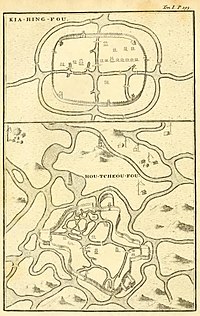|
Jiaxing
Jiaxing (simplified Chinese: 嘉兴; traditional Chinese: 嘉興; pinyin: Jiāxīng; Wade–Giles: Chia-hsing), alternately romanized as Kashing, is a prefecture-level city in northern Zhejiang province, China. Lying on the Grand Canal of China, Jiaxing borders Hangzhou to the southwest, Huzhou to the west, Shanghai to the northeast, and the province of Jiangsu to the north. As of the 2020 census, its population was 5,400,868 and its built-up (or metro) area made of 2 urban districts was home to 1,518,654 inhabitants.[3] AdministrationJiaxing is the birthplace of the Majiabang Culture in the Neolithic Age. The ancestors engaged in farming, animal husbandry, fishing and hunting 7,000 years ago. The prefecture-level city of Jiaxing administers 7 county-level divisions, including 2 districts, 3 county-level cities and 2 counties.
These are further divided into 75 township-level divisions, including 60 towns, 2 townships and 13 subdistricts. History Known as a place
Known as a county
Known as a prefecture
Climate
EconomyIndustry is the main economic driver to the city's economy, contributing 47% to its GDP in 2015. Jiaxing is also well known as the 'hometown of silk', hence it is a famous producer of textiles and woolens. It is one of the world's largest exporters of leather goods. There are mechanical, chemical and electronic industries there. Jiaxing is an important energy base in East China. Qinshan Nuclear Power Plant, the first self-designed nuclear power station in China, and Fangjiashan Nuclear Power Plant (under construction) are located in Haiyan County. Jiaxing Export Processing ZoneEstablished in 2003, Jiaxing Export Processing Zone is a state-level export processing zone approved by State Council. It has a built-up area of 2.98 km2. Its development goal is to become the export processing base for IT, IC, mechanical and electrical, electronics and other high-tech industries.[9] Tourism  South Lake, to the south-east of the old walled city, has been a popular tourist site for centuries. The Chinese Communist Party was officially founded on a boat in the lake, after the delegates to its first congress adjourned their meeting in Shanghai and reconvened here. As a result, the lake is now a popular destination for Communist Party "education" tours. Within the city proper, the Zicheng (citadel) of Jiaxing was for two millennia the fortified nucleus of the walled city, though only fragmented remains now survive from the imeprial era. The main gate was rebuilt in 1990. Jiaxing is one of the very few cities in south-east China that retains any vestige of a citadel. A number of famous writers' homes also survive in the old walled city, as well as a Carmelite abbey and Gothic abbey church built in 1902. Meiwan Street and Yuehe Street (Zhongji Road and surrounds) are two restored neighbourhoods to the south and north of the old city respectively, located near the city moat, canals and lakes. Literally "Prunus bay street" and "moon river street" respectively, these two neighbourhoods combine restored historic buildings and newly landscaped gardens. Meiwan Street features buildings in the style of private residences of prominent families, and is the location of Kim Koo's refuge, a house significant in the history of the Korean independence movement, and a family shrine of the Qian family, a prominent local family. By contrast, Yuehe Street features artisan workshops and street food stores. In January 2022, Yuehe Street was named the "first provincial night cultural and tourist concentration area". Wuzhen and Xitang, two townships within Jiaxing city limits, feature preserved and restored houses situated along small canals that are evocative of typical canal towns of the region. They are popular tourist destinations and filming locations. Transportation The city is served by two railway stations: Jiaxing railway station, on the Shanghai–Kunming railway, and Jiaxing South railway station on the high speed Shanghai–Hangzhou Passenger Railway. The city is served by two long-distance bus stations: Jiaxing North Bus Station and the new Jiaxing Transportation Center. Jiaxing is on the G92 Hangzhou Bay Ring Expressway, G60 Shanghai–Kunming Expressway and China National Highway 320. Jiaxing Air Base is being converted to a public-use airport.[10] LanguageJiaxing dialect is a Northern Wu dialect in the Sujiahu dialect grouping. As such, it is a sister dialect of both Shanghainese and Suzhou dialect, and easily intelligible with both. It is not mutually intelligible with Mandarin or other varieties of Chinese such as Cantonese, Hokkien or Hakka. ReligionLocal people believe in Buddhism, Taoism, Catholicism and Protestantism. Jiaxing Catholic Church and Jiaxing Vincent Abbey are well-known Roman Catholic Churches in Jiaxing. Notable people
See alsoReferences
Bibliography
External linksWikimedia Commons has media related to Jiaxing.
|
||||||||||||||||||||||||||||||||||||||||||||||||||||||||||||||||||||||||||||||||||||||||||||||||||||||||||||||||||||||||||||||||||||||||||||||||||||||||||||||||||||||||||||||||||||||||||||||||||||||||||||||||||||||||||||||||||||||||||||||||||||||||||||||||||||||||||||||||||||||||||||||||||||||||||||||||||||||||||||||||||||||||||






